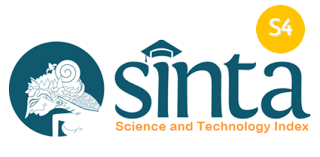PENGOLAHAN AIR PAYAU DENGAN PEMBUBUHAN BESI (II) SULFAT MENGGUNAKAN SARINGAN PASIR SILIKA UNTUK MENGHASILKAN AIR BERSIH
Main Article Content
Abstract
The objective of this research is to assess the limits of chloride concentration in brackish water which can be treated by ferrous sulphate addition to produce clean water. Two types of brackish water were examined, i.e. artificial brackish water and natural brackish water from shallow wells in Sutorejo, Surabaya. The artificial brackish water is made of NaCl solutions which contains 0,6 g Cl-/L, 1,2 g Cl-/L, and 3,65 g Cl-/L. Separation of salt flock from the solution was carried out in silica sand filter. The particle size of silica sand was 2,36 mm and 1,18 mm. Results of the treatments were, brackish water which contains chloride up to 1,2 g Cl-/L were appropriate to be treated by ferrous sulphate to produce chloride less than 0,6 g Cl-/L in accordance with Indonesian clean water quality standard. Addition of ferrous sulphate for the ratio of FeSO4/NaCl = 1,07–2,14 were appropriate to be used without significant influence on process production. The efficiency of chloride deconcentration achieved to about 84%. The particle size of silica sand of 2,36 mm and 1,18 mm did not influence to the quality of treated water for brackish water up to 1,2 g Cl-/L, however, the particle size of 1,18 mm was more efficient for brackish water more than 1,2 g Cl-/L.
Downloads
Article Details
Submission of a manuscript to Jurnal Purifikasi means that the work has never been published in another journal and is not under consideration for publication elsewhere. The author hereby agrees to submit the copyright of the manuscript and its contents to Jurnal Purifikasi, if accepted for publication. Accepted manuscripts will be published in printed form where the ISSN is bound in printed form, not in online form (pdf). Authors are not allowed to publish their work in other forms (journals) without permission from the Jurnal Purifikasi manager.
By submitting a manuscript, the author is deemed to know all the rights and obligations attached to each manuscript.








